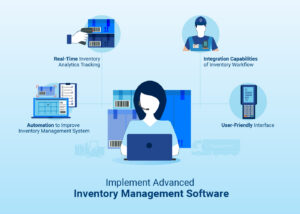How to Improve Inventory Management System
2024-08-02
In today’s businesses which are ever expanding, managing the inventory is a pain area. The rate of success depends on inventory management for businesses of all sizes. “According to a report by McKinsey & Company, companies that implement advanced inventory management practices can reduce inventory costs by up to 30% and improve service levels by up to 15%.” Hence, the organizations are hustling to improve their inventory management system.
The best inventory management software of an organization has the ability to meet customer demands without overstocking or understanding. This is done along with optimizing operational costs and enhancing customer satisfaction. Effective inventory management helps in maintaining the right balance of stock, reducing carrying costs, preventing stockouts and improving the financial stability of the organization. It helps the businesses manage their inventory and also forecast the future needs too. As a result, they can respond to the changing market quickly.
However, till date, many organizations are victims of the obsolete inventory management system. In this blog, we will discuss how to address these issues and the best practices related to improving inventory management systems. This will help you gain a clear understanding of the main operational area on which the businesses thrive.
Implement Advanced Inventory Management Software
Investing in advanced inventory tracking software is one of the most effective ways to improve inventory management system. It enhances the inventory control and also streamlines operations. A simple inventory tracking software can offer a range of features designed for automated inventory management helping in inventory forecasting. Let us take a look at some of them.

Automation to Improve Inventory Management System
Advanced inventory management software automates repetitive tasks such as order placement, data entry etc. This speeds up the ordering process and reduces chances of human error. It helps in freeing up time for the employees to strategize on other tasks. Also, it ensures that the inventory data is updated in real-time hence helping in inventory efficiency and preventing over or under stocking.
Real-Time Inventory Analytics Tracking
With real-time tracking and visibility, companies can monitor stock levels across multiple locations. This visibility helps in making informed decisions to help understand supply chain and better inventory planning control. This helps further to make the best of inventory optimization.
Integration Capabilities of Inventory Workflow
The inventory workflow needs to be automated at certain levels. This is to help improve inventory management system and can be achieved by integration capabilities. The integration will help with smooth data transfer across the organization cutting down the redundant tasks.
User-Friendly Interface
Modern inventory management software should be easy enough for the users to understand. It should be designed so that just the inventory management software demo can help the users access it. This shouldn’t need exhaustive training for the employees. The intuitive dashboards and customizable reports should serve the users for the best to achieve all the objectives of inventory control.
Optimize Inventory Levels
Inventory optimization involves several strategies. It teaches you how to do inventory forecasting accurately. It involves analyzing historic data to predict the future needs. This is followed by setting reorder levels and safety stock levels to prevent shortages. The Just-in-Time (JIT) strategy helps to reduce inventory levels by aligning replenishment with demand. It helps to take care of the carrying cost to the company.
On the other hand ABC analysis helps in prioritizing high-value items for more focus. Monitoring the inventory turnover ratio identifies the slow moving stock and adjusts the inventory levels. Managing lead time ensures timely deliveries. Regular reviews and adjustments help to do the best an organization can to optimize inventory levels and improve inventory management systems.
Objectives of Inventory Control
After all the discussions we had around how to improve inventory management system, seeing the objectives of inventory control can serve as a closure. Inventory control tries to achieve the best it can for any organization dealing with inventory or stocks. The goals include minimizing carrying costs to the company, reducing stockouts and overstocks and improving cash flow. Inventory control aims at enhancing customer satisfaction while avoiding disruptions. Inventory control overall manages the various aspects related to inventory management. It completely works on supporting the business meanwhile also keeping profitability and market demands in mind.
Look no further when it comes to the question of how to improve inventory management system in your organization. We are happy to help you with that. Get in touch with us for a discussion.
Next Steps
Book a 15 day free trial with us!
Get the detailed field service software pricing here.
Want to get ensured before you invest? We got you covered! Find the reviews of some of our clients here.

